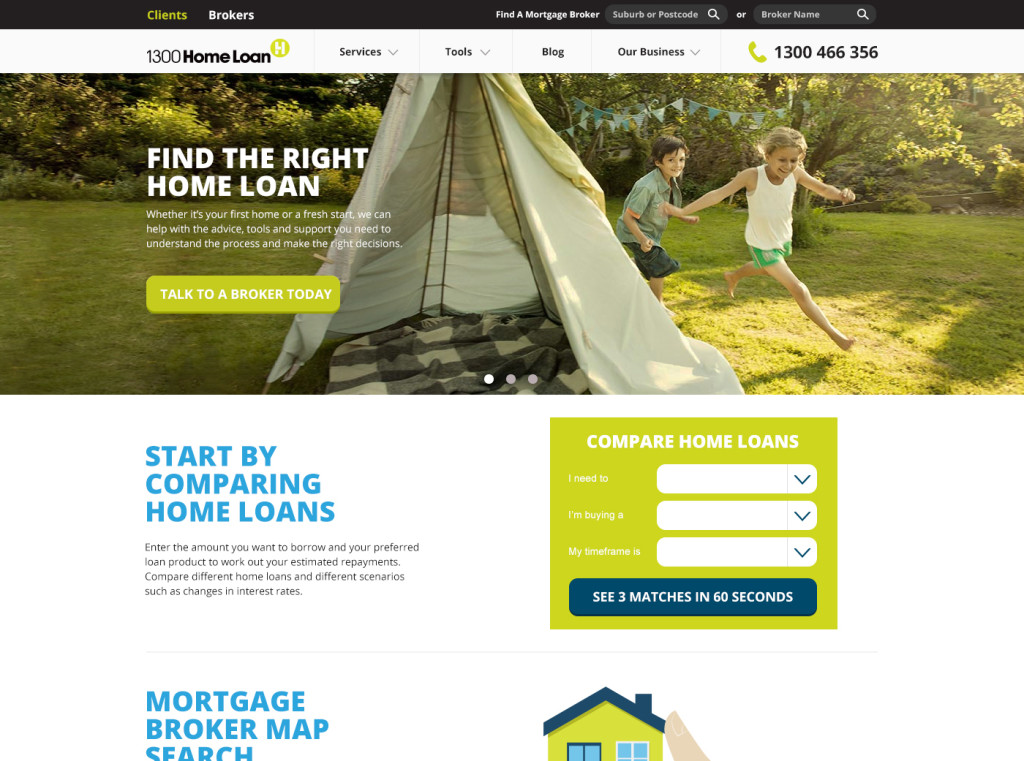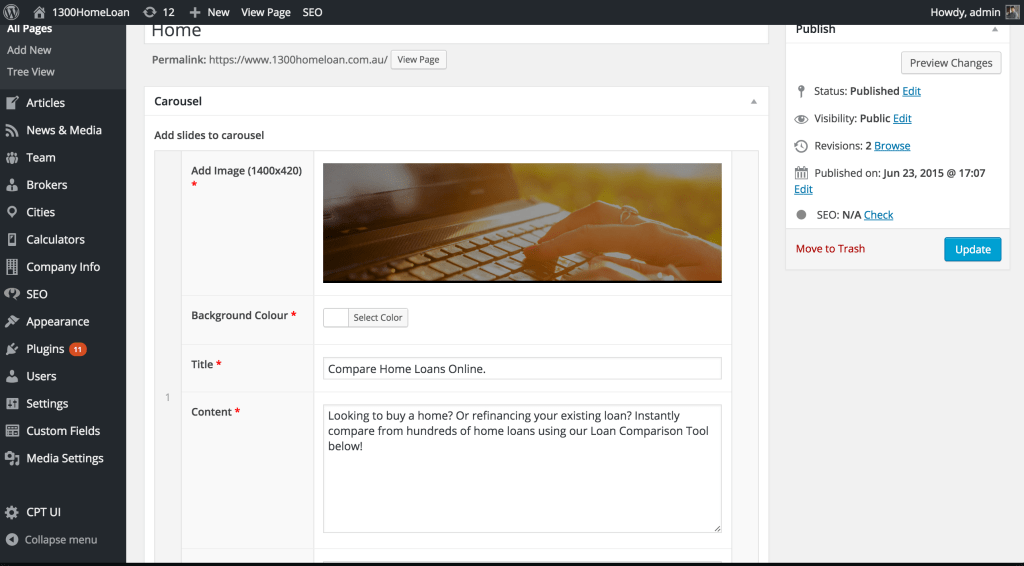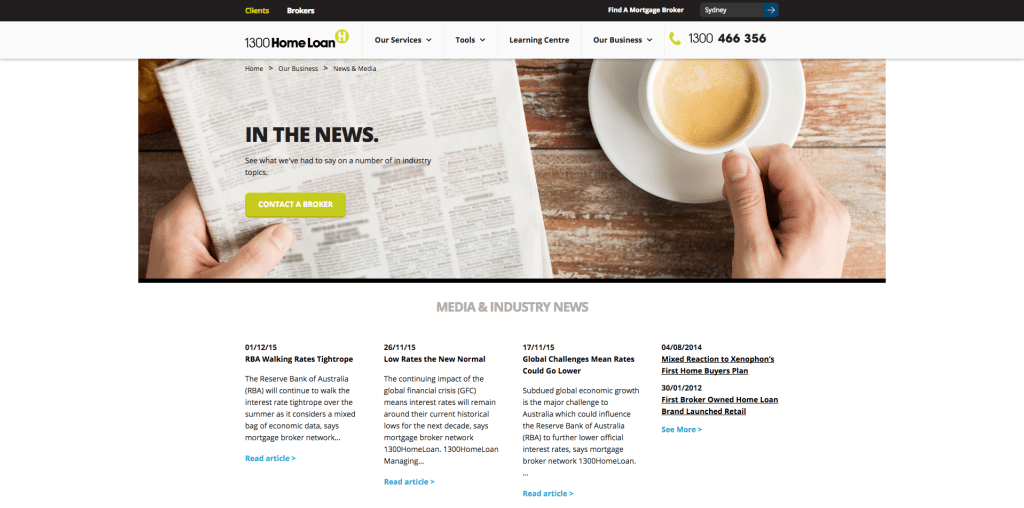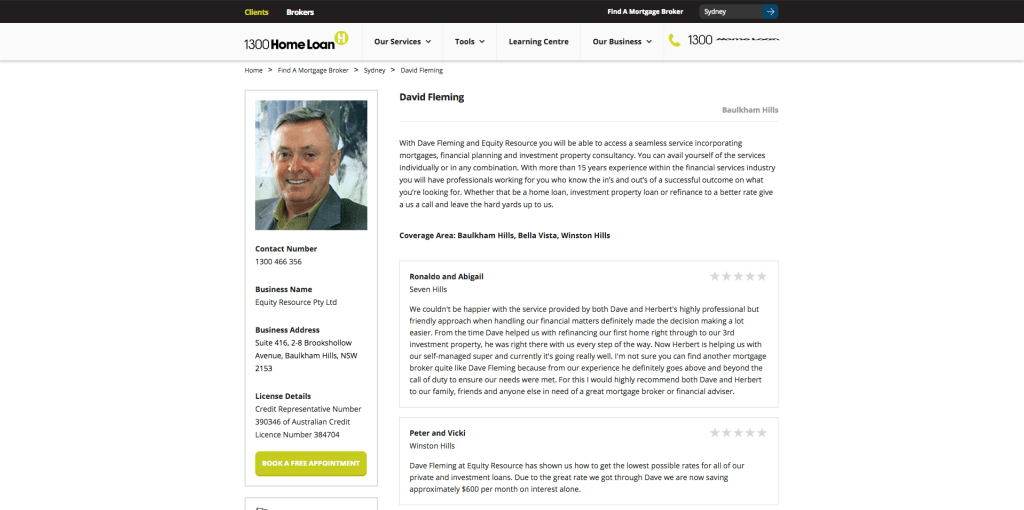
Recently we were tasked with designing and developing the new 1300HomeLoan website. Being an online brand we knew the project would require us to develop the website in a manner that was search-engine-optimised (SEO) in order for the website to improve its search engine results page (SERP) ranking. Because of this, we knew we weren’t going to make the most beautiful of websites but rather, our objective was to balance visual aesthetics with search engine requirements.

The project served as a valuable opportunity for us to create a framework that could be replicated across clientele. I believe this framework can also be used by other designers and businesses looking to employ best practices in the technical deployment of SEO on content-based websites and we have decided to release our comments and guidelines to be used as a case study.
1. Platform: Start with a CMS
>No one knows the exact algorithm Google uses to prioritise website rankings, but sifting through the Google blog, expert opinions and page rank tests carried out by individuals reveals a unified assessment that quality content is the way of the future. On a functional level, this means that the ability to scale and independently create content without 3rd party involvement should be a key priority for businesses. Hence a content management system (CMS) is essential to any website’s long-term success in SERP ranking, as it facilitates the creation of quality content in an efficient and low-cost manner independent of website designers and developers. A great CMS for mortgage brokers and financial experts worth checking out is this one here: mortgagebrokerwebsite.com.au
Platform Options
Throughout our years we have deployed a number of CMS platforms ranging from Drupal, Magento, WordPress, Joomla and much more (we specialise in PHP executions hence why you don’t see platforms of other languages on this list). However, WordPress has now emerged as our CMS of choice for content-based websites (I stress the words ‘content-based’ as there are many different types of websites that serve many different purposes).
The main reasons for this are as follows:
- User friendly back-end – essential to long-term client use
- Large range of existing modules and plugins to leverage from (see below)
- SEM people love it
If you are working on a large project such as 1300HomeLoan, your choice of CMS platform could be heavily influenced by the demands of stakeholders. For example, SEM teams are generally not as development-driven as production teams, and so it is important to consider ease-of-use from the perspective of both the client and the SEM agency. Furthermore, in the case of enterprise-level clients, there may be security or other programming language considerations to take into account which may make WordPress an unfeasible choice.
2. Customisation: User managed content
After selecting a content management platform, the next step is to customise it in order to enable the client to create the type of content they require without having to engage a resource on every request. Doing this will result in the efficient production of content in a timely manner. Some agencies may prefer to keep content changes in-house – as they can then charge on every subsequent update – or alternatively they may not completely the develop the CMS to be autonomous. However, this is hardly conducive to an efficient growth platform as it makes the process of publishing slower.
In the case of 1300HomeLoan, there were two types of customisations implemented:
- Customisation of existing content (Edit)
- Customisation of new content (Create)
Both of these were built into the WordPress CMS to allow the client and SEM team to update content independent of our own team. As part of the implementation we also created multiple users roles based on the level of access required by the individual. This provided access to representatives of the organisation with less technical expertise or access rights to also edit content within their jurisdiction.
Customising existing content
While enabling customisation of existing content may seem like a fairly straightforward process, there are a number of considerations to take into account in even the most simplest of scenarios. This is perhaps why some CMS’ fail – they do not take into account the amount of work involved with independent content creation and editing.
Consider the following section on the 1300HomeLoan homepage:

A technical analysis of the main carousel identifies the following attributes:
- Font – #FFF (white), 38px, Open Sans
- H1 text field
- Paragraph text field
- Automatic carousel rotation
- Responsive
To make this section dynamic requires thought into what may need to be editable in the future. If for example the client had the ability to change the background image, there is a chance they may upload an image that has a lighter background colour rendering the text illegible. Similarly, a wordy heading may result in overlapping text between the H1 and paragraph fields creating a poor user experience. Hence a good CMS will require user restrictions, in order to maintain the integrity of the system over time.

Such problems are regular issues with any CMS as it is often difficult to predict the exact usage of a system that has yet to be utilised. The solution generally lies somewhere between developer imposed user restrictions, and client testing and training. In the development stages, you should set restrictions on the type of content accepted, for example, image resolution, size and format are all controllable, as is font type and character length in text fields. Then by user testing the system with the client, and then training them to use the CMS, you can make them more aware of best practices and furthermore understand some of the common mistakes they may make. It also helps to provide tooltips to the user when they are logged into the CMS (see below right) which remind users of a restraint while they are carrying out an action.

Creating new content
When new content is created via the CMS, clients often have the expectation that the content will be automatically integrated across the website. This is because end-users commonly adopt a WYSIWYG attitude; an end user will create a page and expect the page to be publicly accessible without additional input. Thus the entire process of new content creation including hyperlinking and in-site referencing should be simple enough to meet the user’s expectations to strengthen the cause for consistent content creation.
For the 1300HomeLoan website, we implemented a number of automated processes every time new content was created. Altogether these were designed to optimise lead generation, especially to attract leads for mortgage brokers. These automated processes differed between each type of page but generally contained the following attributes:
- A lead generation form box which integrates into SalesForce CRM
- Lead tracking to determine the page origin of a lead.
- Social sharing capabilities including Open Graph meta tags.
- Consistent URL and breadcrumb structures in-line with the overall architecture.
Some of the unique logic points built into specific page types included (but were not limited to):
Service page
- New service pages are added to the ‘Our Services’ main menu navigation.

News + media page
- News articles are presented as a summary and organised by date.
- On creation of new content, older articles make way for fresh content.

Broker profile page
- Each broker is assigned to a city and state.
- Broker profile content is presented in a summary and profile format.
- Reviews can be created and associated on a broker and city level.

3. Other tips: SEO/SEM considerations
Working with SEM teams over time has revealed regular occurrences in the set of technical requirements that are often requested. Even though we are sharing these technical requirements within the context of the WordPress platform, they can still be applied to any other website platform used. We have implemented these across a range of web design packages offered to SMEs to help their businesses flourish:
Architecture
This is one of the biggest considerations to take into account when developing a new website and working in tandem with an SEO team. Make sure you know what your website architecture is before beginning the development phase. Then build in automation so that when new pages are created via the CMS they too adopt the architecture set in place. Otherwise your website will suffer structurally over the long run as more and more content is edited and created.
Here is what 1300HomeLoan’s url structure looks like:
Mortgage Broker Profiles
parent/mortgage-broker/city/brokerfirstname_brokerlastname
www
Services
parent/services/servicename
www
Blog
parent/blog/articlename
www
Redirects
If you are redeveloping an existing website that already has a considerable amount of traffic and search engine ranking, then redirects should be an essential part of your deployment. Before you launch your new website take into account what pages have disappeared and how your URL structure has changed when comparing the old to new. Then for those pages that no longer exist, use a 301 redirect to get them pointing to the most appropriate page of the new website. This is the recommended practice for redirecting your page ‘juice’ value to the new website.
- Tools: Redirection by John Godley
Lead tracking
Being able to track your lead source is extremely useful information. For large websites with multiple forms we tend to track via the URLs when a user submits a form. We recommend adopting a similar approach, or at least some form of source tracking, as lead tracking will help you determine what are your best performing pages, and in the case of eCommerce websites allow you to make your website more profitable by using the information to make data-driven decisions.
- Tools: Google Analytics by Google
Meta tags
They have been around almost since the beginning of the internet but their value has not decreased. Ensure that you are filling out each page on your site with the right meta descriptions and titles, including Open Graph meta tags for links that can be shared socially. This will help you in both page ranking, and also displaying the right information on search and social indexes when your page is stumbled upon.
As a simple rule make sure all titles are less than 55 characters, and that all your descriptions are less than 155 characters – also remember to include keywords that you are targeting as much as possible in your meta tags.
- Tools: Yoast SEO by Joost de Valk
Final thoughts
I hope that the information we’ve detailed above will help you in those tough decisions you will need to make when creating a website. While these alone will not guarantee you a #1 page rank, it will at the very least provide you with the technical foundations to ensure you are building in the right direction. Over time we have seen many websites fail from a decision as basic as platform choice, and I profess to making some mistakes of my own. However, I believe the WordPress platform is now a formidable option for basic to even advanced deployments for its versatility and support base. Its portfolio speaks for itself, and it is well known some of the biggest content brands in the world are using customised WordPress platforms for their own purposes.







